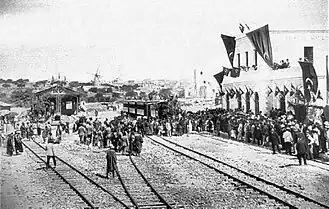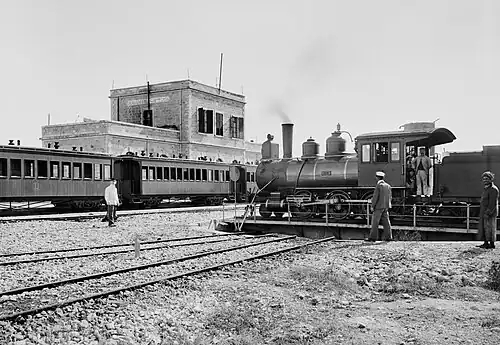Jerusalem–Khan railway station
Jerusalem railway station תחנת הרכבת ירושלים محطة قدس شريف | |
|---|---|
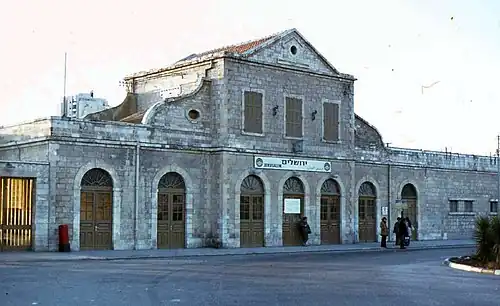 Jerusalem railway station in 1978 | |
| General information | |
| Location | David Remez Street, Jerusalem |
| Line(s) | Tel Aviv – Jerusalem |
| Platforms | 2 (original station) 2 (revived station) |
| Tracks | 4 (original station) 4 (revived station) |
| Construction | |
| Structure type | Surface-level station (original station) Deep-level pylon two-vault station (revived station) |
| Depth | Ground level (original station) 42 metres (138 ft) (revived station) |
| History | |
| Opened | 26 September 1892 |
| Closed | 15 August 1998 |
The Jerusalem railway station (Hebrew: תחנת הרכבת ירושלים, Tahanat HaRakevet Yerushalayim; Arabic: محطة قدس شريف) is a historic railway station in Jerusalem, located between Hebron Road and Bethlehem Road, near the German Colony. It is also known as the Jerusalem–Khan railway station (Hebrew: תחנת הרכבת ירושלים – החאן, Tahanat HaRakevet Yerushalayim–HaKhan) after the caravanserai building, now the Khan Theater located across the road, to differentiate it from the Jerusalem–Malha and Jerusalem–Yitzhak Navon stations opened after its closure. It was part of the Jaffa–Jerusalem railway until its closure in 1998.
The station opened in 1892 during the Ottoman period as a terminus of the Jaffa–Jerusalem line, at the 86.6 kilometer mark and an elevation of 787 metres (2,582 ft).[1] In 1998 this railway along with the station were closed and the station was not included in the restoration of the Tel Aviv – Jerusalem line, completed in 2005.[2] The station lay neglected for many years, although the railway yard was used for annual events such as Hebrew Book Week. After undergoing an extensive restoration, it reopened as a culture and entertainment center in May 2013.[3]
History
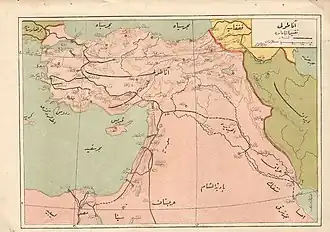
The idea to build a railway linking the coast with the Jerusalem was first raised in the middle of the 19th century by Dr. Conrad Schick, Moses Montefiore and others. The franchise for laying the railway was obtained from the Ottoman government by Joseph Navon, but due to financial difficulties, he had to sell the franchise to a French company which was set up to build the line – Société du Chemin de Fer Ottoman de Jaffa à Jérusalem et Prolongements.[4]
In 1892, construction of the line from Jaffa to Jerusalem was finally completed. It was built along the "donkeys' trail", an ancient route ascending to Jerusalem which passed through Nahal Sorek and the Valley of Rephaim. The station was inaugurated on 26 September 1892 in the presence of the city's dignitaries, Jews and Arabs. Among those present at the ceremony was Eliezer Ben Yehuda, the reviver of the Hebrew language, which gave the train the literal name of – horse of the steel in Hebrew as the word Rakevet had not yet been created.[5]
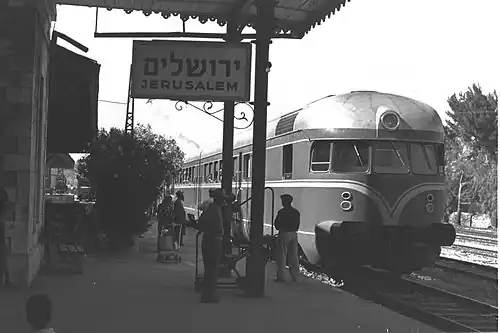
On 30 October 1946 an Irgun suitcase bomb caused severe damage to the station. A British sapper was killed while attempting to defuse the bomb. Five of the militants were captured by police, four of them were wounded.[7] One of the injured was 17-year-old Meir Feinstein.[8] according to his older brother, Benjamin Feinstein, Meir required the amputation of his arm as a result of delayed medical attention in prison.[9][10] Both captured militants were initially sentenced death.[11] However, neither were executed. The older militant, Daniel Azuli, had his sentence comuted.[12] The teenage amputee, Meir Feinstein, blew himself up in prison 6 months later, alongside Moshe Barazani, a Lehi militant who had also been sentenced to death for "terrorism" and who was held in the same death row cell.[8] The pair used concealed hand grenades that had been constructed by Eliezer Ben-Ami, another Lehi militant held at the same prison.[13][6] Meir and Moshe were buried at the Mount of Olives Jewish Cemetery, the Irgun commander and his wife were later buried next to them.[14][15][16] Ben-Ami was released from prison and joined the IDF, after Israel declared independence.[a]
The station operated almost continuously until 1948, when traffic stopped on the Jaffa–Jerusalem line due to the 1948 Arab–Israeli War. At the end of the war a section of the track near Beit Safafa, an Arab neighborhood in southeastern Jerusalem, remained under the control of the Jordanian Arab Legion. Following the 1949 Armistice Agreements, it was agreed that Jordan would hand the control of this section of the track to Israel, in order to enable Israel Railways to restart the service to Jerusalem.[5]
As a result, between 1948 and 1967 the Beit Safafa neighborhood was divided; the area south of the railway line was part of the Jordanian controlled West Bank and the railway line itself and small area to the North part of the Israeli controlled section of Jerusalem. The service on the line resumed on 7 August 1949.[5]
In 1959 the railway tracks to Jerusalem underwent extensive renovations, but over time, the number of passengers using the line decreased, especially after the opening of Highway 1. For the majority of the years until the line was finally closed, there was only once or twice daily service to Tel Aviv South railway station (now also closed) and / or Haifa Center (now Center HaShmona) railway station. During the 1990s, due to the poor level of railway tracks maintenance, there were many minor derailments;[17] therefore it was decided to close the section of the Jaffa–Jerusalem railway line from Beit Shemesh railway station along Nahal Sorek to Jerusalem. On 14 August 1998 the last train service left the station, and on 15 August 1998 the station was officially closed. The Beit Shemesh–Jerusalem section was later renovated and reopened in 2005, but only reached the Malha neighborhood, with the railway between the newly-built Malha railway station and the original Jerusalem station having been abandoned. The section from Malha to Beit Shemesh was closed again in 2020 following the COVID-19 pandemic, citing poor ridership and long journey times (especially compared to the new Tel Aviv-Jerusalem railway) and the railway's long, winding course causing excessive damage to train axles.
The station building
The station building is a symmetrical structure containing the station offices, ticket hall and a Concourse. The original building (before later modifications) was identical to the Jaffa railway station building and the original Ramla railway station building, which were all built at the same time.[5] The triangular arches on the roof of the first floor, on both sides of the ticket hall, were built in early 1920s by the British-run Palestine Railway, who managed the railway during the British Mandate of Palestine. The building underwent many renovations over the years, but its basic shape has not changed since 1920.[5]
Restoration and reopening as an entertainment venue
After its closure, the station sat abandoned and suffered from neglect and vandalism. In the 2000s, the area around the station was used for cultural events such as the Jerusalem Film Festival, Jerusalem Jazz Festival and Israel Festival.[18]
In May 2013, the station reopened as HaTakhana HaRishona ("The First Station"), a culture and entertainment venue. The $9.3 million refurbishment was financed by the Jerusalem Municipality and the Jerusalem Development Authority. The 4,000 sq.m. rail yard now features wooden decks, food stalls and umbrella-topped vendor carts. Several restaurants and pubs have opened in the area, and an exhibition of historic photographs is displayed inside the station house. The site hosts musical, literary and artistic events, and adjoins a bike path that links it to the Train Track Park, a walking and cycling path built along the route of the old train tracks.[3] The line's other original terminus, the Jaffa train station, also underwent a similar restoration which was completed in 2009. In 2017, the Railway Station compound resumed hosting the Hebrew Book Week, after having moved between various locations in the city, and has hosted it there ever since.[19][20]
Jerusalem– Herzliya/Binyamina Line | |||||||||||||||||||||||||||||||||||||||||||||||||||||||||||||||||||||||||||||||||||||||||||||||||||||||||||||||||||||||||||||||||||||||||||||||||||||||||||||||||||||||||||||||||||||||||||||||||||||||||||||||||||||||||||||||||||||||||||||||||||||||||||||||||||||||||||||||||||||||||||||||||
|---|---|---|---|---|---|---|---|---|---|---|---|---|---|---|---|---|---|---|---|---|---|---|---|---|---|---|---|---|---|---|---|---|---|---|---|---|---|---|---|---|---|---|---|---|---|---|---|---|---|---|---|---|---|---|---|---|---|---|---|---|---|---|---|---|---|---|---|---|---|---|---|---|---|---|---|---|---|---|---|---|---|---|---|---|---|---|---|---|---|---|---|---|---|---|---|---|---|---|---|---|---|---|---|---|---|---|---|---|---|---|---|---|---|---|---|---|---|---|---|---|---|---|---|---|---|---|---|---|---|---|---|---|---|---|---|---|---|---|---|---|---|---|---|---|---|---|---|---|---|---|---|---|---|---|---|---|---|---|---|---|---|---|---|---|---|---|---|---|---|---|---|---|---|---|---|---|---|---|---|---|---|---|---|---|---|---|---|---|---|---|---|---|---|---|---|---|---|---|---|---|---|---|---|---|---|---|---|---|---|---|---|---|---|---|---|---|---|---|---|---|---|---|---|---|---|---|---|---|---|---|---|---|---|---|---|---|---|---|---|---|---|---|---|---|---|---|---|---|---|---|---|---|---|---|---|---|---|---|---|---|---|---|---|---|---|---|---|---|---|---|---|---|---|---|---|---|---|---|---|---|---|---|---|---|---|---|---|---|---|
| |||||||||||||||||||||||||||||||||||||||||||||||||||||||||||||||||||||||||||||||||||||||||||||||||||||||||||||||||||||||||||||||||||||||||||||||||||||||||||||||||||||||||||||||||||||||||||||||||||||||||||||||||||||||||||||||||||||||||||||||||||||||||||||||||||||||||||||||||||||||||||||||||
-
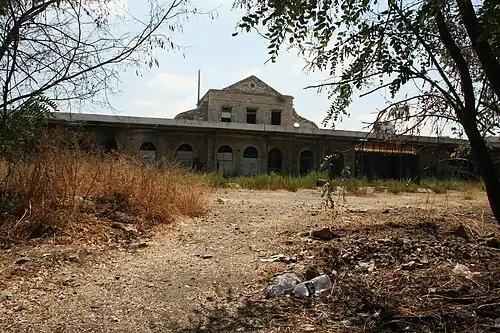 Jerusalem railway station in 2008 before being extensively restored.
Jerusalem railway station in 2008 before being extensively restored. -
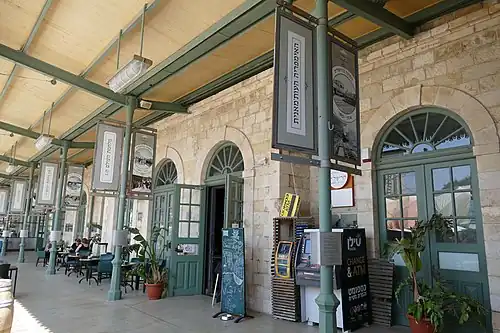 After restoration as a leisure and entertainment venue.
After restoration as a leisure and entertainment venue.
Future railway station
The station is expected to return to active railway service as part of National Infrastructure Plan 108, which provides for the extension of the New Tel Aviv–Jerusalem railway to Jerusalem–Malha. The station would be turned into a through station, with the original route to the southwest leading to Malha being complemented by a new route to the northwest, leading to the Jerusalem–Yitzhak Navon railway station (the current terminus) via a completely new underground station in central Jerusalem. However, due to engineering constraints, the revived station would be built in a shallow underground structure (like Navon station, although not nearly as deep), and the railway will only reach surface level at Malha station.
Detailed plans unveiled in November 2021[21] foresee that the Station's platforms will be located 42 meters underground. The historical station structure's roof will be restored to its original dimensions, but it will remain an entertainment venue; the main entrance will be built in a separate glass structure. Two secondary entrances will be built, one north of the station complex in the Liberty Bell Park, and the other facing Hebron Road, in the extreme south of the station lot.
Like the existing Navon and Malha stations, as well as the planned Jerusalem-Central station, the revived Jerusalem-Khan will have two island platforms servicing four tracks.[21] Each Island platform will be built in a vault, and both vaults will be linked by direct overpasses to escalators and elevators leading to the surface; as opposed to Jerusalem-Navon's structure, where the surface escalators and elevators only lead to a central vault, from which overpasses extend to the platforms.
Gallery
- Modern photos of the original signage in three languages.
-
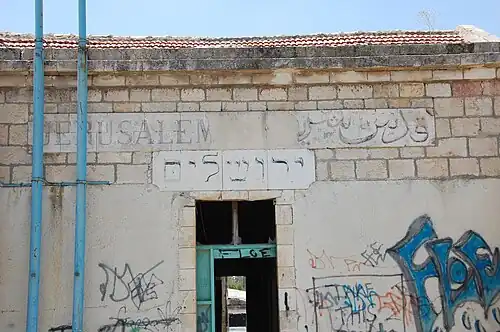
-
.jpg)
-

- Historical photos of the station.
-
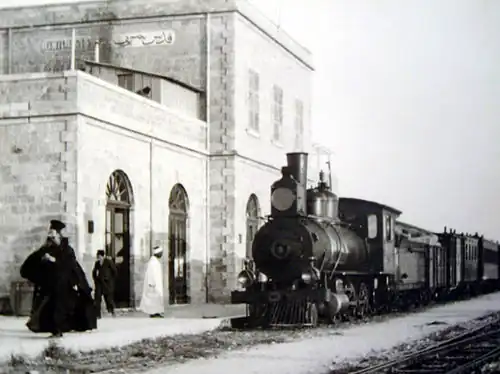 Historic photo of the station
Historic photo of the station -
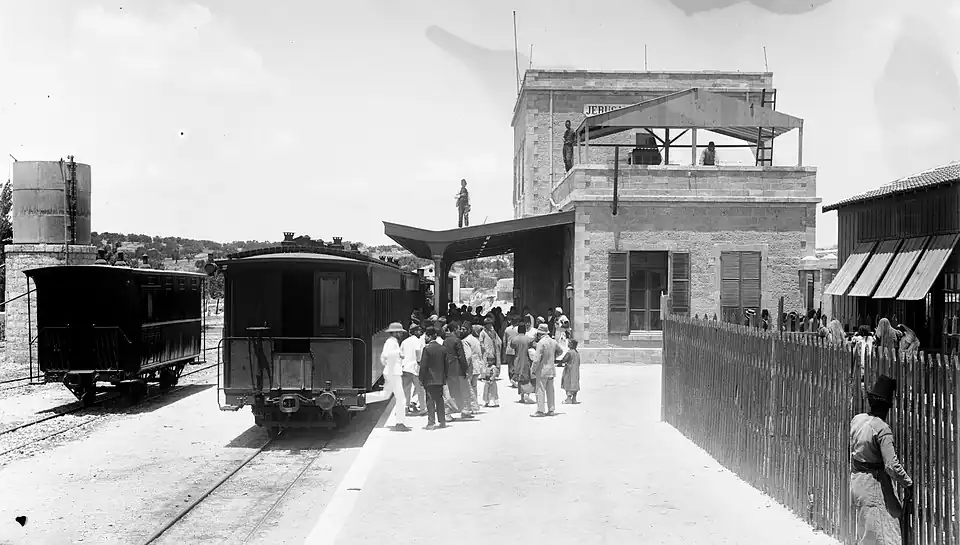 The station in the early 20th century
The station in the early 20th century
See also
Notes
References
- ^ Travis, Anthony S. (2009). On Chariots with Horses of Fire and Iron. Jerusalem, Israel: Magnes Press. p. 74. ISBN 978-965-91147-0-2.
- ^ Ehrlich, Sybil (11 April 2005), "New train service proves a hit in Jerusalem and Ashkelon. Capital's rail link renewed after almost seven years", Jerusalem Post, archived from the original on 31 January 2013, retrieved 6 November 2009
- ^ a b Klein Leichman, Abigail (30 January 2013). "Old Jerusalem station to be transformed into top culture spot". Israel 21c. Archived from the original on 24 September 2015. Retrieved 25 September 2013. (subscription)
- ^ Glass, Yosef, "Yosef Navon Bey and his involvement in late 19th century Palestine's development", Cathedra (In Hebrew)., 62 (1992)
- ^ a b c d e Wallach, Yair, "Nostalgia and Promise in Jerusalem's Derelict Ottoman Railway Station", The Jerusalem Quarterly, Summer 2009 (38), retrieved 6 November 2009
- ^ a b Klein, Yair (3 May 2022). היום בהיסטוריה: פיינשטיין וברזני מקדימים את התליין [Today in History: Feinstein and Barzani outrun the executioner]. srugim.co.il (in Hebrew). Israel. Archived from the original on 30 June 2025. תמות נפשי עם פלשתים — ברזני ופינשטיין עירקי ואשכנזי ישבו ביחד בתא הנידונים למוות וחיכו בשלווה ליום מותם. איש לח"י אליעזר בן עמי העלה את רעיון שמשון תמות נפשי עם בריטים. והכין לשניים תפוז נפץ כדי שביום התלייה גם התליינים יתפוצצו. [My soul will die with the Philistines — Barzani and Feinstein, Iraqi and Ashkenazi, sat together in the death row cell and calmly awaited the day of their death. A Lehi member, Eliezer Ben-Ami, came up with the idea of Samson dying with the British, and he prepared an explosive orange for the two of them so that on the day of the hanging, the executioners would also explode.] (Note: "today in history" is the anniversary according to the Hebrew calendar)
- ^ קורבן טוהר הנשק. Haaretz הארץ (in Hebrew). 3 July 2001. [Five of them were captured, including four wounded, two of them in serious condition. One of them, the driver of the car, Meir Feinstein, was brought to a military trial five months later, sentenced to death, and blew himself up in the gallows dungeon along with Moshe Barzani, a member of Lehi, a few hours before the date set for their hanging.]
- ^ a b כל הדרך לגרדום: ימיו האחרונים של מאיר פיינשטיין. Makor Rishon (in Hebrew). 27 July 2017.
מאיר פיינשטיין נולד וגדל בירושלים. אם שואלים את אתר הזיכרון הרשמי של חללי צה"ל או את ויקיפדיה, תאריך הלידה שלו הוא 5 באוקטובר 1927. לדברי אחיינו, המועד הנכון הוא יולי 1929.
- ^ Feinstein, Benjamin (1947). "archived letters" (PDF). www.infocenters.co.il. Jerusalem. p. 14-15. Archived from the original (PDF) on 11 May 2025. * page 15,
… I feel it my duty to my brother to make it. This relation to the circumstances which caused the loss of my brother's erm. It came to my knowledge that when my brother was found wounded in a private home after that he had nearly bet all his blood, the soldiers did not behave in a manner befitting the British Amay. Instead of giving him immediate aid and take him to a hospital they took him to Military B. Q. in the German Colony, thereby losing a lot of precious time. It is very likely that had medical aid been immediately granted to my brother his arm could have been saved.
* page 14,quote from page 14
- ^ Feinstein, Benjamin; Feinstein, Bella (1947). "Petitions for Meir Feinstein & Moshe Barzani" (PDF). www.infocenters.co.il. Jerusalem, Palestine. p. 5, 10. Archived from the original (PDF) on 11 May 2025. * Feinstein, Benjamin (1 April 1947), Letter to: The President, Military Court Jerusalem, Karem Quarter, Jerusalem, p. 10,
Now regarding the age of my brother Meir. So far the Prosecutors has tendered the following evidence on the subject: 1. A Birth Certificate issued by the Health Department, Government of Palestine, stating that the age of my brother Meir is 17 years 8 months. 2. My mother's sworn affidavit to the same effect. Medical Report by the Government Medical Officer, who was instructed to examine my brother at the request of the prosecutor, stating that my brother's age is 17½ yearв. Evidence by two military doctors that the age of my brother is 23-26 years.
{{citation}}: CS1 maint: location missing publisher (link) * Feinstein, Bella (April 1947), SWORN by the said Mrs. BELLA FEINSTEIN of Jerusalem, before mе, Magistrete at Jerusalem this day of April 1947., p. 5,This affidavit is sworn in support of an application for a judgment declaring that my said son Meir was born in Jerusalem on the 30th day of July 1929, or alternatively that on the 3rd day of April, 1947 he had not yet attained the age of 18 years.
- ^ "Two More Palestinian Jews Sentenced to Death; Seven Now Stand in Shadow of Gallows". Jewish Telegraphic Agency. 4 April 1947. Archived from the original on 11 May 2025.
Feinstein was sentenced to death following a government "expert's" testimony that he was at least 18 years old. The death sentence may not be imposed on anybody under that age. His brother attempted several times to tell the court that he was only 17, but he was refused permission to testify. Since the defendant's birth certificate was missing, the "expert" was ordered to estimate his age.
- ^ "Palestine Military Commander Orders Two More Jews to Hang; Commutes Sentence of Third". Jewish Telegraphic Agency. 18 April 1947.
Lt. Gen. Gordon H.A. MacMillan, Palestine military commander, today confirmed the death sentences imposed on two Palestine Jews and commuted the sentence of a third to life imprisonment. Under amendments to the Emrgency Defense Regulations published yesterday there is no appeal from his decision. The condemned men are Moshe Barazani, 21, and Meir Feinstein, whose age the prosecution claims is 23. The third youth is Daniel Azulai. … Feinstein's mother insists that her son, a veteran of the British Army, is only 17. Barazani was captured in Jerusalem during the imposition of martial law with hand grenade in his possession. The other two youths were charged with having participated in an attack on the Jerusalem central railroad station last October.
- ^ Weisstuch, Moshe (21 May 2021). בגיל 98: לוחם המחתרת שסייע להתאבדות עולי הגרדום לא מתחרט [At 98: The underground fighter who helped the suicide of the Gallows immigrants has no regrets]. Israel Hayom (in Hebrew). Archived from the original on 7 May 2025.
- ^ המועצה להנצחת זכרם ופועלם של נשיאי ישראל וראשי ממשלה. 12 January 2022. [Menachem Begin died on 9 March 1992, and at his request, he was buried next to his wife Aliza, and near the graves of the Olei Hagardom Meir Feinstein and Moshe Barzani, on the Mount of Olives in Jerusalem, and not in the Greatest of the Nations section on Mount Herzl.]
- ^ מתחברים להר הזיתים - פרק 1: גבורתם של עולי הגרדום [Connecting to the Mount of Olives - Chapter 1: The Heroism of the Gallows Pilgrims]. סרוגים (in Hebrew).
Moshe Barzani and Meir Feinstein, who were sentenced to death and, on the night before their execution, beat the executioner to the punch and blew themselves up in the cell of the condemned in Jerusalem prison. Forty years after their deaths, they became a symbol in the 1981 elections when they were mentioned by Prime Minister Menachem Begin in the famous Tchachahim speech, and he even asked to be buried next to them.
- ^ פריט ארכיון. www.jabotinsky.org. מכון ז'בוטינסקי.
- ^ Ehrlich, Sybil (1 September 1995), "No Tel Aviv-Haifa train service today", Jerusalem Post, archived from the original on 2 November 2012, retrieved 6 November 2009
- ^ "Moonlight Cinema at the Old Train Station", The Jerusalemite – the Jerusalem Culture Guide – July 14, 2008, retrieved 6 November 2009
- ^ Gamish, Rafi (7 June 2017). שבוע הספר העברי בירושלים: החגיגה מתחילה הערב במתחם התחנה | כל העיר. כל העיר ירושלים (in Hebrew). Retrieved 14 January 2025.
- ^ שבוע הספר 2024 בירושלים. התחנה הראשונה ירושלים (in Hebrew). Retrieved 14 January 2025.
- ^ a b "מנהל התכנון".
- ^ אלבז-אלוש, קורין (24 May 2023). חיל החלוץ: צה"ל חוגג 75, ואלו שהתגייסו עם הקמתו זוכרים איך הכול התחיל [Pioneer Corps: The IDF celebrates 75 years, and those who enlisted when it was founded remember how it all began]. Ynet (in Hebrew). Archived from the original on 26 May 2023.
- ^ Elbaz Alush, Korin (25 May 2023). "In honor of IDF's 75th anniversary, first recruits share stories from the frontlines". Ynetnews. – Note: this is an English version, not a direct translation of the story in Hebrew edition. Some details are explained more for foreign readers, and other details are left out.
